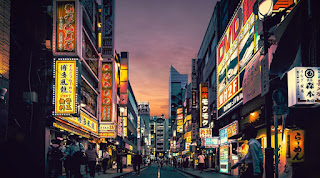Tokyo
The history of Tokyo, the capital city of Japan, is a tale of transformation and growth. Here is a condensed version of the history of Tokyo:
Edo Period (1603-1868) :
Tokyo was originally known as Edo and served as the seat of power for the Tokugawa shogunate. During this period, Edo developed into a thriving city and cultural center, marked by economic prosperity and the rise of the samurai class.
Meiji Restoration (1868) :
The Meiji Restoration marked a pivotal turning point in Japanese history. The capital was moved from Kyoto to Edo, which was renamed Tokyo, meaning "Eastern Capital." The Meiji government aimed to modernize Japan and establish Tokyo as a symbol of the nation's progress.
Modernization and Expansion (Late 19th-Early 20th century) :
Tokyo experienced rapid growth and modernization during the late 19th and early 20th centuries. Western-style infrastructure, including railways, telegraphs, and Western architecture, transformed the cityscape.
Great Kanto Earthquake (1923) :
The Great Kanto Earthquake of 1923 devastated Tokyo, causing widespread destruction and loss of life. The city was rebuilt with modern urban planning and infrastructure.
World War II and Post-War Reconstruction :
Tokyo suffered heavy damage during World War II, especially during the firebombings of 1945. After the war, the city underwent a process of reconstruction and economic recovery.
Economic Boom and Urban Development :
In the post-war era, Tokyo experienced remarkable economic growth and became a global economic powerhouse. The city's skyline transformed with the construction of high-rise buildings and modern urban infrastructure.
Hosting the Olympic Games :
Tokyo hosted the Summer Olympic Games in 1964, which showcased the city's technological advancements and brought international attention to Japan's recovery after World War II. Tokyo will also host the Olympics in 2021 (2020 Summer Olympics).
Cultural and Technological Hub :
Tokyo is a vibrant hub of culture, entertainment, and technological innovation. It is known for its world-class museums, theaters, fashion districts, and technological advancements in areas such as electronics and robotics.
Future Challenges :
Tokyo continues to face challenges of urbanization, population growth, and environmental sustainability. The city strives to balance economic development with preserving its cultural heritage and improving the quality of life for its residents.
Today, Tokyo stands as one of the most populous and influential cities in the world, known for its cutting-edge technology, distinct culture, and bustling city life. Its rich history has shaped its identity as a modern metropolis deeply rooted in tradition.
Tokyo, the bustling capital city of Japan, offers a wide range of attractions that blend modernity with rich cultural heritage. Here are some of the top attractions in Tokyo :
Meiji Shrine : Located in the heart of Tokyo, the Meiji Shrine is a tranquil oasis surrounded by lush forests. It is dedicated to Emperor Meiji and Empress Shoken, and visitors can witness traditional Shinto rituals and explore beautiful grounds.
Senso-ji Temple : Visit Tokyo's oldest and most famous temple, Senso-ji, located in the historic Asakusa district. Explore the colorful Nakamise shopping street leading to the temple and experience traditional Japanese culture.
Tokyo Skytree : Enjoy breathtaking views of the city from the Tokyo Skytree, one of the world's tallest freestanding towers. The observation decks offer panoramic vistas and a chance to see the cityscape from a different perspective.
Tsukiji Fish Market : Visit the Tsukiji Fish Market, one of the world's largest wholesale fish markets. Explore the bustling market, try fresh seafood, and witness the famous tuna auctions (now held in a new location called Toyosu Market).
Shibuya Crossing : Experience the famous Shibuya Crossing, one of the busiest pedestrian crossings in the world. Watch as thousands of people cross the intersection simultaneously when the traffic lights change.
Akihabara : Immerse yourself in the vibrant and electric atmosphere of Akihabara, known as the center of Japanese pop culture and electronics. Explore anime and manga shops, arcades, and maid cafes.
Ginza : Shop in the upscale Ginza district, known for its luxury boutiques, department stores, and high-end restaurants. It is a paradise for fashion enthusiasts and those looking for a refined shopping experience.
Odaiba : Visit Odaiba, a man-made island in Tokyo Bay. Explore futuristic architecture, shopping centers, amusement parks, and enjoy stunning views of the city skyline.
Ueno Park : Take a stroll in Ueno Park, a spacious park that houses several museums and cultural institutions, including the Tokyo National Museum and Ueno Zoo.
Harajuku : Experience the unique fashion and street culture of Harajuku. Explore Takeshita Street, known for its quirky fashion boutiques, crepe stands, and trendy cafés.
Tokyo Disneyland and DisneySea: Visit the magical world of Tokyo Disneyland and DisneySea, offering thrilling rides, live shows, and beloved Disney characters.
These attractions represent just a fraction of what Tokyo has to offer. The city is a vibrant blend of tradition and innovation, with countless neighborhoods, shopping districts, museums, and cultural sites waiting to be explored.
TOKYO JAPAN - Shinjuku Shopping Street Walking
Fact about Tokyo :-
Tokyo is the most populous metropolitan area in the world. As of 2021, the Greater Tokyo Area, which includes the 23 special wards of Tokyo and surrounding prefectures, has a population of over 37 million people. This makes it not only the most populous city in Japan but also the most populous urban area globally. The sheer size and density of Tokyo's population contribute to its vibrant energy, bustling streets, and diverse culture.




0 Comments